The broadband value chain Assignment 2022
VerifiedAdded on 2022/02/25
|14
|4551
|30
Assignment
AI Summary
Contribute Materials
Your contribution can guide someone’s learning journey. Share your
documents today.
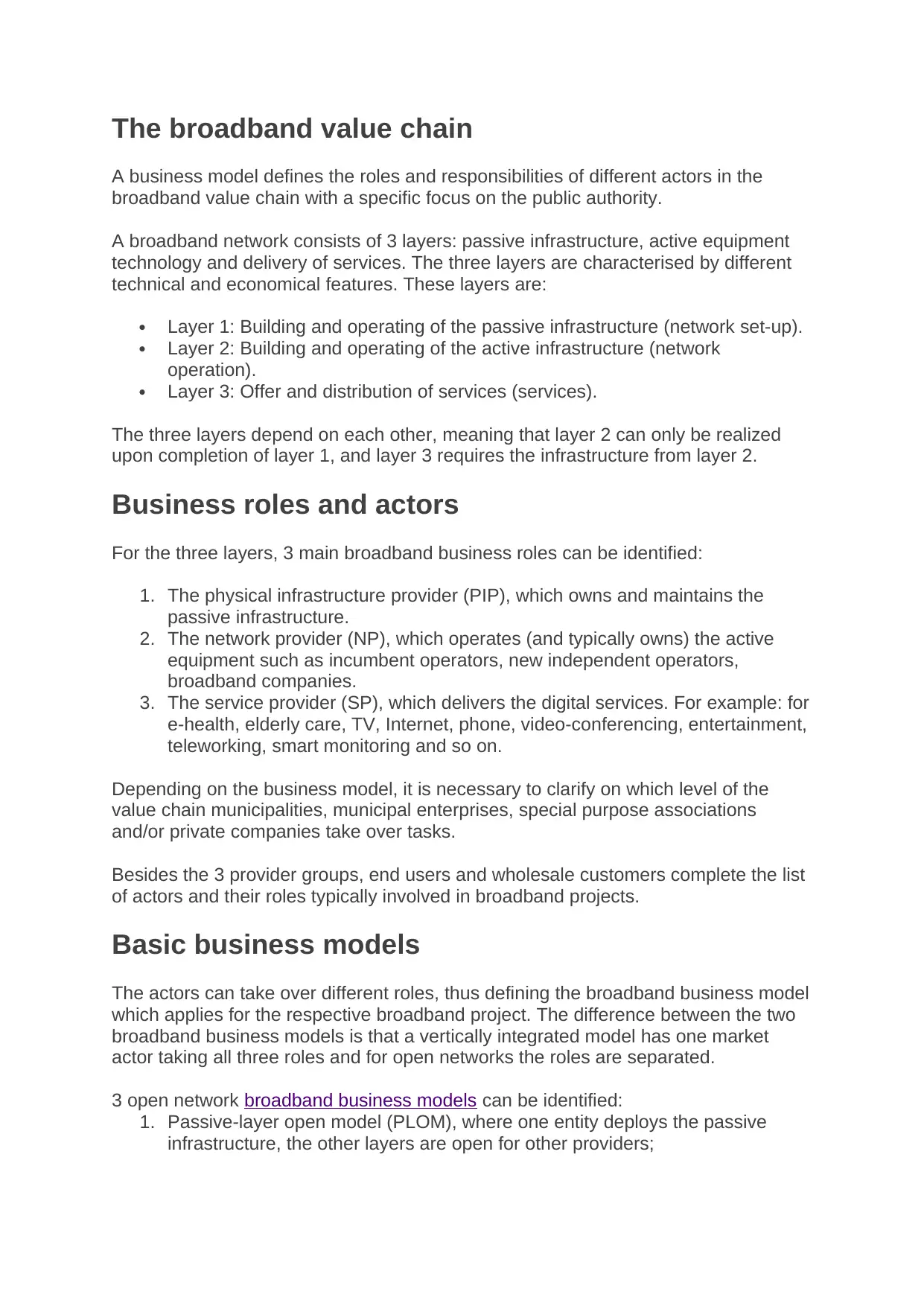
The broadband value chain
A business model defines the roles and responsibilities of different actors in the
broadband value chain with a specific focus on the public authority.
A broadband network consists of 3 layers: passive infrastructure, active equipment
technology and delivery of services. The three layers are characterised by different
technical and economical features. These layers are:
Layer 1: Building and operating of the passive infrastructure (network set-up).
Layer 2: Building and operating of the active infrastructure (network
operation).
Layer 3: Offer and distribution of services (services).
The three layers depend on each other, meaning that layer 2 can only be realized
upon completion of layer 1, and layer 3 requires the infrastructure from layer 2.
Business roles and actors
For the three layers, 3 main broadband business roles can be identified:
1. The physical infrastructure provider (PIP), which owns and maintains the
passive infrastructure.
2. The network provider (NP), which operates (and typically owns) the active
equipment such as incumbent operators, new independent operators,
broadband companies.
3. The service provider (SP), which delivers the digital services. For example: for
e-health, elderly care, TV, Internet, phone, video-conferencing, entertainment,
teleworking, smart monitoring and so on.
Depending on the business model, it is necessary to clarify on which level of the
value chain municipalities, municipal enterprises, special purpose associations
and/or private companies take over tasks.
Besides the 3 provider groups, end users and wholesale customers complete the list
of actors and their roles typically involved in broadband projects.
Basic business models
The actors can take over different roles, thus defining the broadband business model
which applies for the respective broadband project. The difference between the two
broadband business models is that a vertically integrated model has one market
actor taking all three roles and for open networks the roles are separated.
3 open network broadband business models can be identified:
1. Passive-layer open model (PLOM), where one entity deploys the passive
infrastructure, the other layers are open for other providers;
A business model defines the roles and responsibilities of different actors in the
broadband value chain with a specific focus on the public authority.
A broadband network consists of 3 layers: passive infrastructure, active equipment
technology and delivery of services. The three layers are characterised by different
technical and economical features. These layers are:
Layer 1: Building and operating of the passive infrastructure (network set-up).
Layer 2: Building and operating of the active infrastructure (network
operation).
Layer 3: Offer and distribution of services (services).
The three layers depend on each other, meaning that layer 2 can only be realized
upon completion of layer 1, and layer 3 requires the infrastructure from layer 2.
Business roles and actors
For the three layers, 3 main broadband business roles can be identified:
1. The physical infrastructure provider (PIP), which owns and maintains the
passive infrastructure.
2. The network provider (NP), which operates (and typically owns) the active
equipment such as incumbent operators, new independent operators,
broadband companies.
3. The service provider (SP), which delivers the digital services. For example: for
e-health, elderly care, TV, Internet, phone, video-conferencing, entertainment,
teleworking, smart monitoring and so on.
Depending on the business model, it is necessary to clarify on which level of the
value chain municipalities, municipal enterprises, special purpose associations
and/or private companies take over tasks.
Besides the 3 provider groups, end users and wholesale customers complete the list
of actors and their roles typically involved in broadband projects.
Basic business models
The actors can take over different roles, thus defining the broadband business model
which applies for the respective broadband project. The difference between the two
broadband business models is that a vertically integrated model has one market
actor taking all three roles and for open networks the roles are separated.
3 open network broadband business models can be identified:
1. Passive-layer open model (PLOM), where one entity deploys the passive
infrastructure, the other layers are open for other providers;
Secure Best Marks with AI Grader
Need help grading? Try our AI Grader for instant feedback on your assignments.
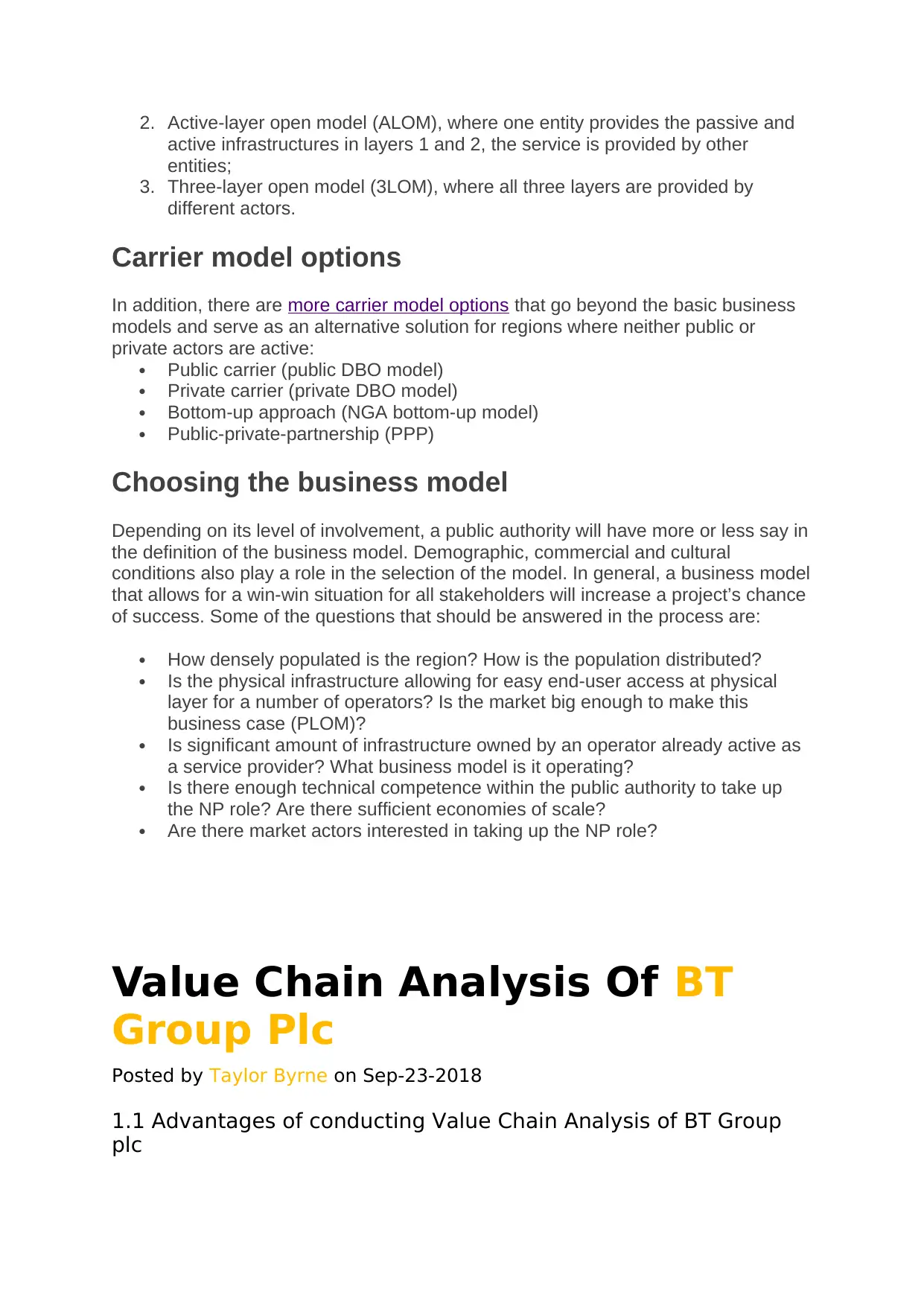
2. Active-layer open model (ALOM), where one entity provides the passive and
active infrastructures in layers 1 and 2, the service is provided by other
entities;
3. Three-layer open model (3LOM), where all three layers are provided by
different actors.
Carrier model options
In addition, there are more carrier model options that go beyond the basic business
models and serve as an alternative solution for regions where neither public or
private actors are active:
Public carrier (public DBO model)
Private carrier (private DBO model)
Bottom-up approach (NGA bottom-up model)
Public-private-partnership (PPP)
Choosing the business model
Depending on its level of involvement, a public authority will have more or less say in
the definition of the business model. Demographic, commercial and cultural
conditions also play a role in the selection of the model. In general, a business model
that allows for a win-win situation for all stakeholders will increase a project’s chance
of success. Some of the questions that should be answered in the process are:
How densely populated is the region? How is the population distributed?
Is the physical infrastructure allowing for easy end-user access at physical
layer for a number of operators? Is the market big enough to make this
business case (PLOM)?
Is significant amount of infrastructure owned by an operator already active as
a service provider? What business model is it operating?
Is there enough technical competence within the public authority to take up
the NP role? Are there sufficient economies of scale?
Are there market actors interested in taking up the NP role?
Value Chain Analysis Of BT
Group Plc
Posted by Taylor Byrne on Sep-23-2018
1.1 Advantages of conducting Value Chain Analysis of BT Group
plc
active infrastructures in layers 1 and 2, the service is provided by other
entities;
3. Three-layer open model (3LOM), where all three layers are provided by
different actors.
Carrier model options
In addition, there are more carrier model options that go beyond the basic business
models and serve as an alternative solution for regions where neither public or
private actors are active:
Public carrier (public DBO model)
Private carrier (private DBO model)
Bottom-up approach (NGA bottom-up model)
Public-private-partnership (PPP)
Choosing the business model
Depending on its level of involvement, a public authority will have more or less say in
the definition of the business model. Demographic, commercial and cultural
conditions also play a role in the selection of the model. In general, a business model
that allows for a win-win situation for all stakeholders will increase a project’s chance
of success. Some of the questions that should be answered in the process are:
How densely populated is the region? How is the population distributed?
Is the physical infrastructure allowing for easy end-user access at physical
layer for a number of operators? Is the market big enough to make this
business case (PLOM)?
Is significant amount of infrastructure owned by an operator already active as
a service provider? What business model is it operating?
Is there enough technical competence within the public authority to take up
the NP role? Are there sufficient economies of scale?
Are there market actors interested in taking up the NP role?
Value Chain Analysis Of BT
Group Plc
Posted by Taylor Byrne on Sep-23-2018
1.1 Advantages of conducting Value Chain Analysis of BT Group
plc
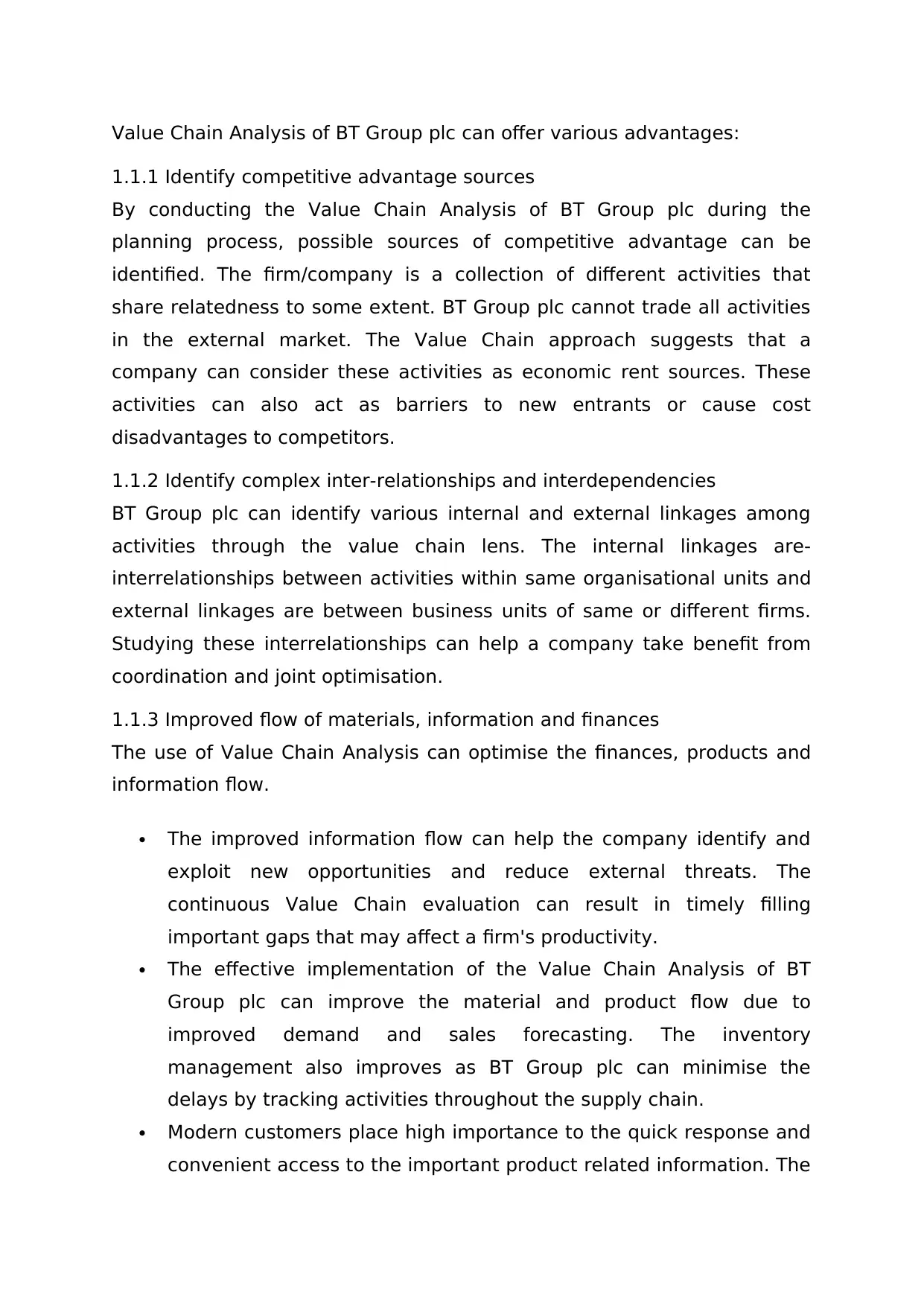
Value Chain Analysis of BT Group plc can offer various advantages:
1.1.1 Identify competitive advantage sources
By conducting the Value Chain Analysis of BT Group plc during the
planning process, possible sources of competitive advantage can be
identified. The firm/company is a collection of different activities that
share relatedness to some extent. BT Group plc cannot trade all activities
in the external market. The Value Chain approach suggests that a
company can consider these activities as economic rent sources. These
activities can also act as barriers to new entrants or cause cost
disadvantages to competitors.
1.1.2 Identify complex inter-relationships and interdependencies
BT Group plc can identify various internal and external linkages among
activities through the value chain lens. The internal linkages are-
interrelationships between activities within same organisational units and
external linkages are between business units of same or different firms.
Studying these interrelationships can help a company take benefit from
coordination and joint optimisation.
1.1.3 Improved flow of materials, information and finances
The use of Value Chain Analysis can optimise the finances, products and
information flow.
The improved information flow can help the company identify and
exploit new opportunities and reduce external threats. The
continuous Value Chain evaluation can result in timely filling
important gaps that may affect a firm's productivity.
The effective implementation of the Value Chain Analysis of BT
Group plc can improve the material and product flow due to
improved demand and sales forecasting. The inventory
management also improves as BT Group plc can minimise the
delays by tracking activities throughout the supply chain.
Modern customers place high importance to the quick response and
convenient access to the important product related information. The
1.1.1 Identify competitive advantage sources
By conducting the Value Chain Analysis of BT Group plc during the
planning process, possible sources of competitive advantage can be
identified. The firm/company is a collection of different activities that
share relatedness to some extent. BT Group plc cannot trade all activities
in the external market. The Value Chain approach suggests that a
company can consider these activities as economic rent sources. These
activities can also act as barriers to new entrants or cause cost
disadvantages to competitors.
1.1.2 Identify complex inter-relationships and interdependencies
BT Group plc can identify various internal and external linkages among
activities through the value chain lens. The internal linkages are-
interrelationships between activities within same organisational units and
external linkages are between business units of same or different firms.
Studying these interrelationships can help a company take benefit from
coordination and joint optimisation.
1.1.3 Improved flow of materials, information and finances
The use of Value Chain Analysis can optimise the finances, products and
information flow.
The improved information flow can help the company identify and
exploit new opportunities and reduce external threats. The
continuous Value Chain evaluation can result in timely filling
important gaps that may affect a firm's productivity.
The effective implementation of the Value Chain Analysis of BT
Group plc can improve the material and product flow due to
improved demand and sales forecasting. The inventory
management also improves as BT Group plc can minimise the
delays by tracking activities throughout the supply chain.
Modern customers place high importance to the quick response and
convenient access to the important product related information. The
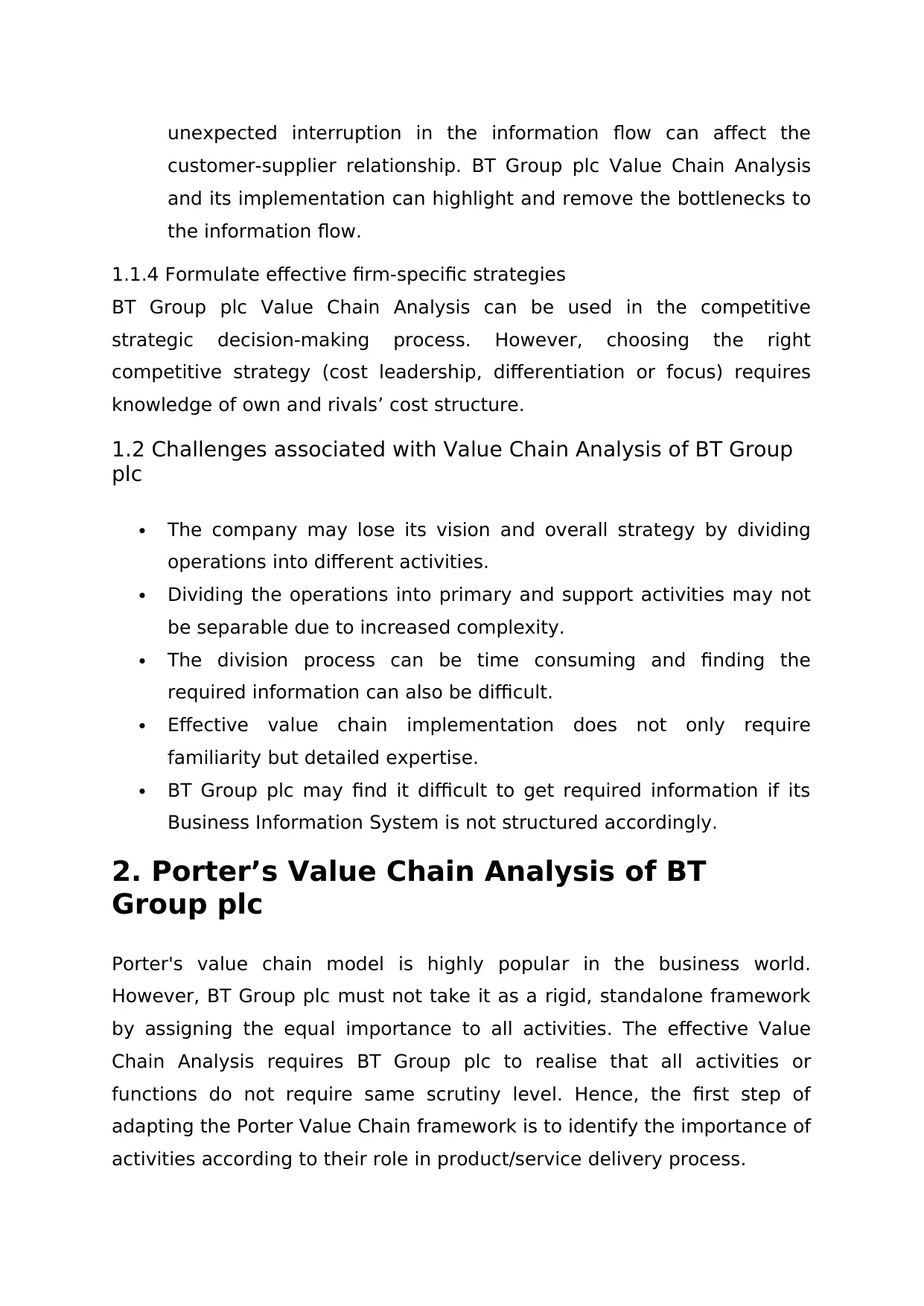
unexpected interruption in the information flow can affect the
customer-supplier relationship. BT Group plc Value Chain Analysis
and its implementation can highlight and remove the bottlenecks to
the information flow.
1.1.4 Formulate effective firm-specific strategies
BT Group plc Value Chain Analysis can be used in the competitive
strategic decision-making process. However, choosing the right
competitive strategy (cost leadership, differentiation or focus) requires
knowledge of own and rivals’ cost structure.
1.2 Challenges associated with Value Chain Analysis of BT Group
plc
The company may lose its vision and overall strategy by dividing
operations into different activities.
Dividing the operations into primary and support activities may not
be separable due to increased complexity.
The division process can be time consuming and finding the
required information can also be difficult.
Effective value chain implementation does not only require
familiarity but detailed expertise.
BT Group plc may find it difficult to get required information if its
Business Information System is not structured accordingly.
2. Porter’s Value Chain Analysis of BT
Group plc
Porter's value chain model is highly popular in the business world.
However, BT Group plc must not take it as a rigid, standalone framework
by assigning the equal importance to all activities. The effective Value
Chain Analysis requires BT Group plc to realise that all activities or
functions do not require same scrutiny level. Hence, the first step of
adapting the Porter Value Chain framework is to identify the importance of
activities according to their role in product/service delivery process.
customer-supplier relationship. BT Group plc Value Chain Analysis
and its implementation can highlight and remove the bottlenecks to
the information flow.
1.1.4 Formulate effective firm-specific strategies
BT Group plc Value Chain Analysis can be used in the competitive
strategic decision-making process. However, choosing the right
competitive strategy (cost leadership, differentiation or focus) requires
knowledge of own and rivals’ cost structure.
1.2 Challenges associated with Value Chain Analysis of BT Group
plc
The company may lose its vision and overall strategy by dividing
operations into different activities.
Dividing the operations into primary and support activities may not
be separable due to increased complexity.
The division process can be time consuming and finding the
required information can also be difficult.
Effective value chain implementation does not only require
familiarity but detailed expertise.
BT Group plc may find it difficult to get required information if its
Business Information System is not structured accordingly.
2. Porter’s Value Chain Analysis of BT
Group plc
Porter's value chain model is highly popular in the business world.
However, BT Group plc must not take it as a rigid, standalone framework
by assigning the equal importance to all activities. The effective Value
Chain Analysis requires BT Group plc to realise that all activities or
functions do not require same scrutiny level. Hence, the first step of
adapting the Porter Value Chain framework is to identify the importance of
activities according to their role in product/service delivery process.
Secure Best Marks with AI Grader
Need help grading? Try our AI Grader for instant feedback on your assignments.
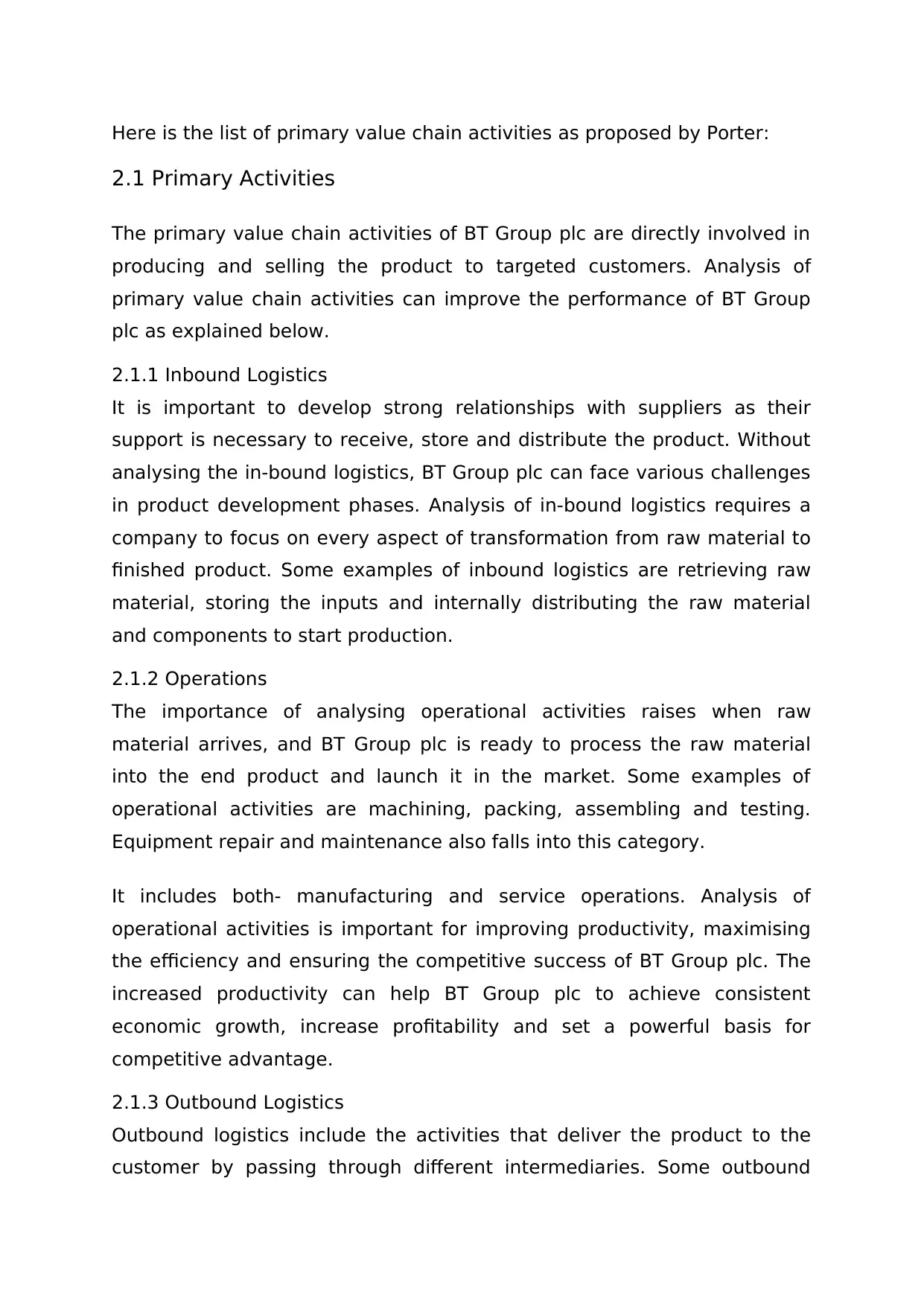
Here is the list of primary value chain activities as proposed by Porter:
2.1 Primary Activities
The primary value chain activities of BT Group plc are directly involved in
producing and selling the product to targeted customers. Analysis of
primary value chain activities can improve the performance of BT Group
plc as explained below.
2.1.1 Inbound Logistics
It is important to develop strong relationships with suppliers as their
support is necessary to receive, store and distribute the product. Without
analysing the in-bound logistics, BT Group plc can face various challenges
in product development phases. Analysis of in-bound logistics requires a
company to focus on every aspect of transformation from raw material to
finished product. Some examples of inbound logistics are retrieving raw
material, storing the inputs and internally distributing the raw material
and components to start production.
2.1.2 Operations
The importance of analysing operational activities raises when raw
material arrives, and BT Group plc is ready to process the raw material
into the end product and launch it in the market. Some examples of
operational activities are machining, packing, assembling and testing.
Equipment repair and maintenance also falls into this category.
It includes both- manufacturing and service operations. Analysis of
operational activities is important for improving productivity, maximising
the efficiency and ensuring the competitive success of BT Group plc. The
increased productivity can help BT Group plc to achieve consistent
economic growth, increase profitability and set a powerful basis for
competitive advantage.
2.1.3 Outbound Logistics
Outbound logistics include the activities that deliver the product to the
customer by passing through different intermediaries. Some outbound
2.1 Primary Activities
The primary value chain activities of BT Group plc are directly involved in
producing and selling the product to targeted customers. Analysis of
primary value chain activities can improve the performance of BT Group
plc as explained below.
2.1.1 Inbound Logistics
It is important to develop strong relationships with suppliers as their
support is necessary to receive, store and distribute the product. Without
analysing the in-bound logistics, BT Group plc can face various challenges
in product development phases. Analysis of in-bound logistics requires a
company to focus on every aspect of transformation from raw material to
finished product. Some examples of inbound logistics are retrieving raw
material, storing the inputs and internally distributing the raw material
and components to start production.
2.1.2 Operations
The importance of analysing operational activities raises when raw
material arrives, and BT Group plc is ready to process the raw material
into the end product and launch it in the market. Some examples of
operational activities are machining, packing, assembling and testing.
Equipment repair and maintenance also falls into this category.
It includes both- manufacturing and service operations. Analysis of
operational activities is important for improving productivity, maximising
the efficiency and ensuring the competitive success of BT Group plc. The
increased productivity can help BT Group plc to achieve consistent
economic growth, increase profitability and set a powerful basis for
competitive advantage.
2.1.3 Outbound Logistics
Outbound logistics include the activities that deliver the product to the
customer by passing through different intermediaries. Some outbound
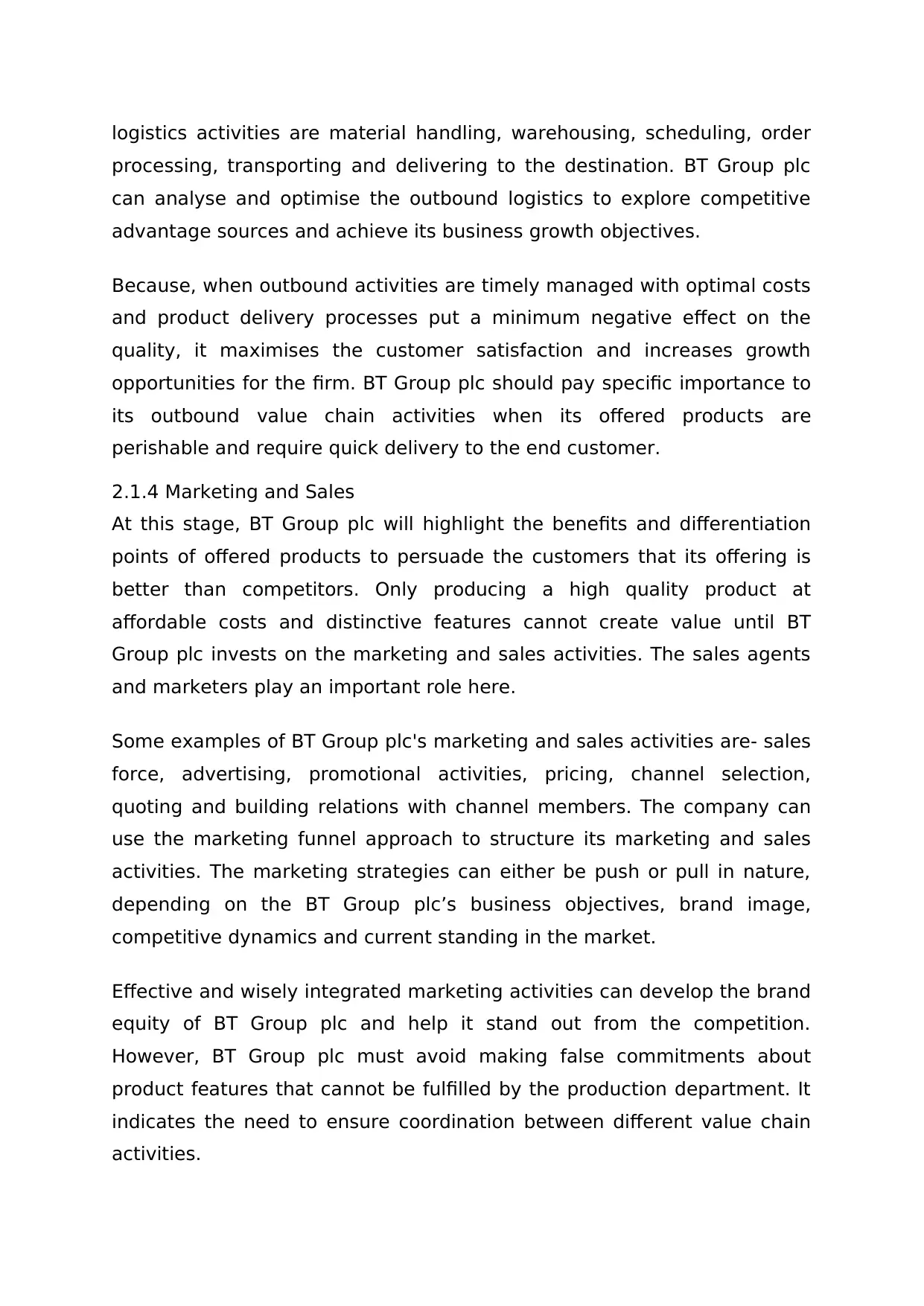
logistics activities are material handling, warehousing, scheduling, order
processing, transporting and delivering to the destination. BT Group plc
can analyse and optimise the outbound logistics to explore competitive
advantage sources and achieve its business growth objectives.
Because, when outbound activities are timely managed with optimal costs
and product delivery processes put a minimum negative effect on the
quality, it maximises the customer satisfaction and increases growth
opportunities for the firm. BT Group plc should pay specific importance to
its outbound value chain activities when its offered products are
perishable and require quick delivery to the end customer.
2.1.4 Marketing and Sales
At this stage, BT Group plc will highlight the benefits and differentiation
points of offered products to persuade the customers that its offering is
better than competitors. Only producing a high quality product at
affordable costs and distinctive features cannot create value until BT
Group plc invests on the marketing and sales activities. The sales agents
and marketers play an important role here.
Some examples of BT Group plc's marketing and sales activities are- sales
force, advertising, promotional activities, pricing, channel selection,
quoting and building relations with channel members. The company can
use the marketing funnel approach to structure its marketing and sales
activities. The marketing strategies can either be push or pull in nature,
depending on the BT Group plc’s business objectives, brand image,
competitive dynamics and current standing in the market.
Effective and wisely integrated marketing activities can develop the brand
equity of BT Group plc and help it stand out from the competition.
However, BT Group plc must avoid making false commitments about
product features that cannot be fulfilled by the production department. It
indicates the need to ensure coordination between different value chain
activities.
processing, transporting and delivering to the destination. BT Group plc
can analyse and optimise the outbound logistics to explore competitive
advantage sources and achieve its business growth objectives.
Because, when outbound activities are timely managed with optimal costs
and product delivery processes put a minimum negative effect on the
quality, it maximises the customer satisfaction and increases growth
opportunities for the firm. BT Group plc should pay specific importance to
its outbound value chain activities when its offered products are
perishable and require quick delivery to the end customer.
2.1.4 Marketing and Sales
At this stage, BT Group plc will highlight the benefits and differentiation
points of offered products to persuade the customers that its offering is
better than competitors. Only producing a high quality product at
affordable costs and distinctive features cannot create value until BT
Group plc invests on the marketing and sales activities. The sales agents
and marketers play an important role here.
Some examples of BT Group plc's marketing and sales activities are- sales
force, advertising, promotional activities, pricing, channel selection,
quoting and building relations with channel members. The company can
use the marketing funnel approach to structure its marketing and sales
activities. The marketing strategies can either be push or pull in nature,
depending on the BT Group plc’s business objectives, brand image,
competitive dynamics and current standing in the market.
Effective and wisely integrated marketing activities can develop the brand
equity of BT Group plc and help it stand out from the competition.
However, BT Group plc must avoid making false commitments about
product features that cannot be fulfilled by the production department. It
indicates the need to ensure coordination between different value chain
activities.
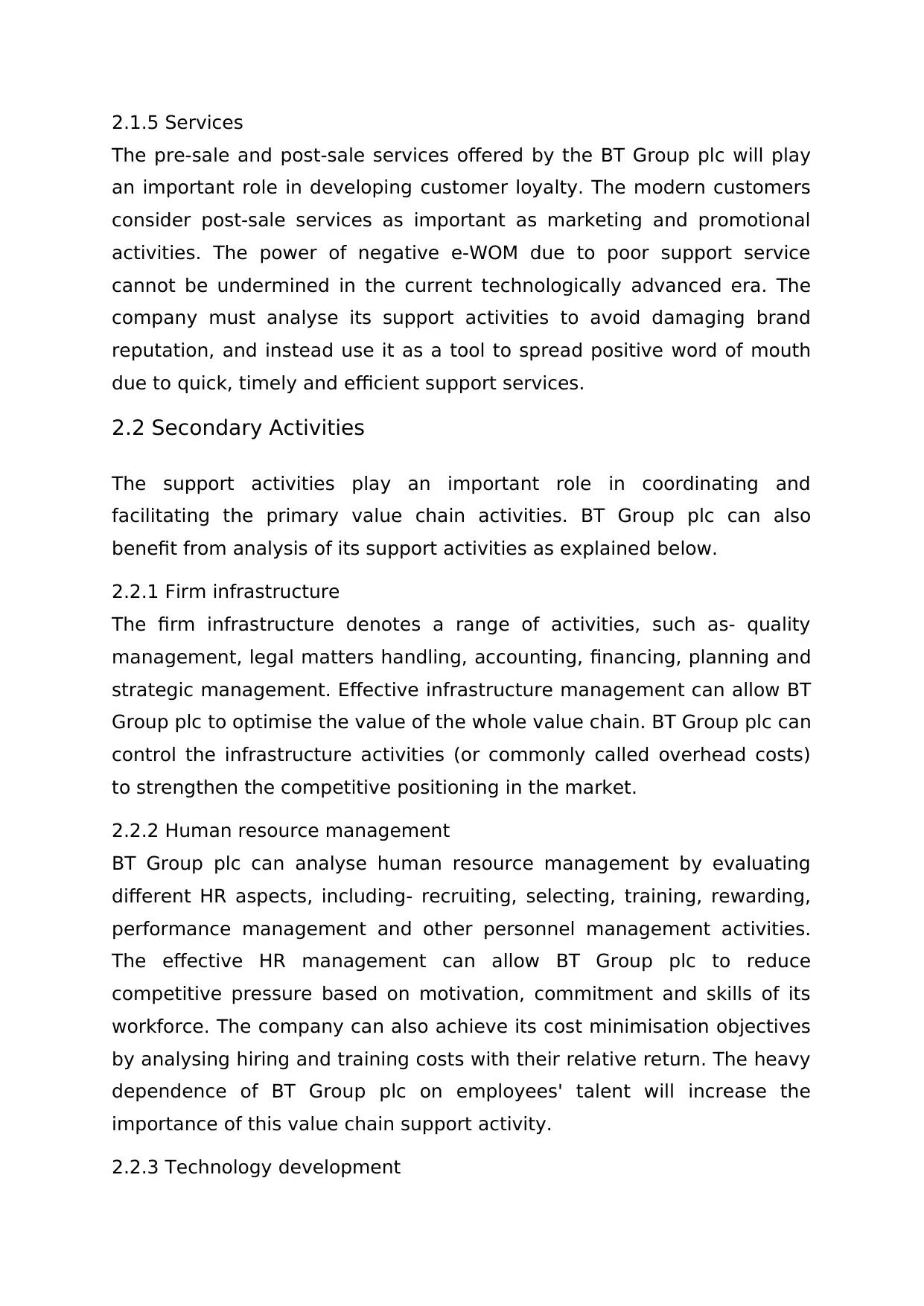
2.1.5 Services
The pre-sale and post-sale services offered by the BT Group plc will play
an important role in developing customer loyalty. The modern customers
consider post-sale services as important as marketing and promotional
activities. The power of negative e-WOM due to poor support service
cannot be undermined in the current technologically advanced era. The
company must analyse its support activities to avoid damaging brand
reputation, and instead use it as a tool to spread positive word of mouth
due to quick, timely and efficient support services.
2.2 Secondary Activities
The support activities play an important role in coordinating and
facilitating the primary value chain activities. BT Group plc can also
benefit from analysis of its support activities as explained below.
2.2.1 Firm infrastructure
The firm infrastructure denotes a range of activities, such as- quality
management, legal matters handling, accounting, financing, planning and
strategic management. Effective infrastructure management can allow BT
Group plc to optimise the value of the whole value chain. BT Group plc can
control the infrastructure activities (or commonly called overhead costs)
to strengthen the competitive positioning in the market.
2.2.2 Human resource management
BT Group plc can analyse human resource management by evaluating
different HR aspects, including- recruiting, selecting, training, rewarding,
performance management and other personnel management activities.
The effective HR management can allow BT Group plc to reduce
competitive pressure based on motivation, commitment and skills of its
workforce. The company can also achieve its cost minimisation objectives
by analysing hiring and training costs with their relative return. The heavy
dependence of BT Group plc on employees' talent will increase the
importance of this value chain support activity.
2.2.3 Technology development
The pre-sale and post-sale services offered by the BT Group plc will play
an important role in developing customer loyalty. The modern customers
consider post-sale services as important as marketing and promotional
activities. The power of negative e-WOM due to poor support service
cannot be undermined in the current technologically advanced era. The
company must analyse its support activities to avoid damaging brand
reputation, and instead use it as a tool to spread positive word of mouth
due to quick, timely and efficient support services.
2.2 Secondary Activities
The support activities play an important role in coordinating and
facilitating the primary value chain activities. BT Group plc can also
benefit from analysis of its support activities as explained below.
2.2.1 Firm infrastructure
The firm infrastructure denotes a range of activities, such as- quality
management, legal matters handling, accounting, financing, planning and
strategic management. Effective infrastructure management can allow BT
Group plc to optimise the value of the whole value chain. BT Group plc can
control the infrastructure activities (or commonly called overhead costs)
to strengthen the competitive positioning in the market.
2.2.2 Human resource management
BT Group plc can analyse human resource management by evaluating
different HR aspects, including- recruiting, selecting, training, rewarding,
performance management and other personnel management activities.
The effective HR management can allow BT Group plc to reduce
competitive pressure based on motivation, commitment and skills of its
workforce. The company can also achieve its cost minimisation objectives
by analysing hiring and training costs with their relative return. The heavy
dependence of BT Group plc on employees' talent will increase the
importance of this value chain support activity.
2.2.3 Technology development
Paraphrase This Document
Need a fresh take? Get an instant paraphrase of this document with our AI Paraphraser
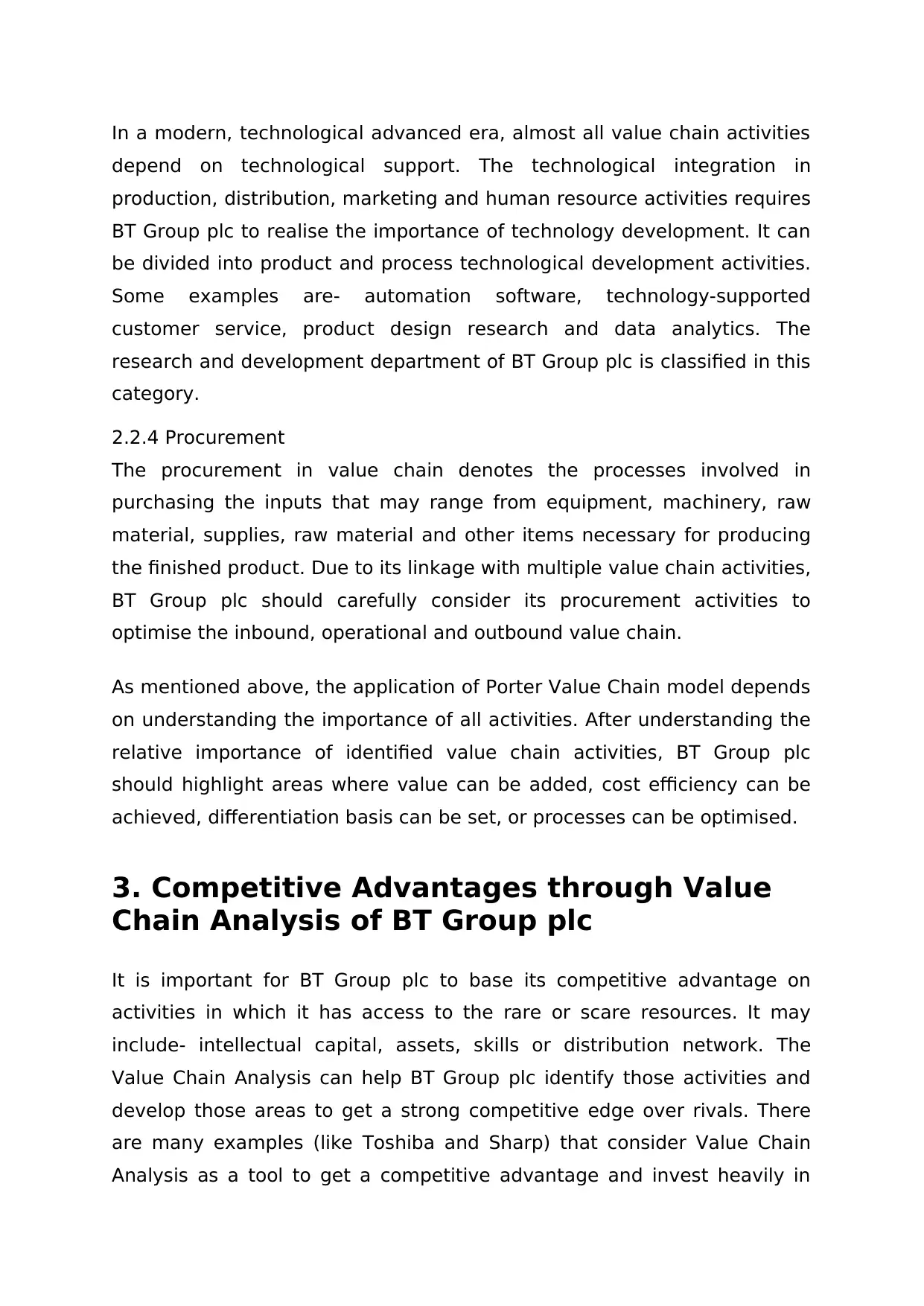
In a modern, technological advanced era, almost all value chain activities
depend on technological support. The technological integration in
production, distribution, marketing and human resource activities requires
BT Group plc to realise the importance of technology development. It can
be divided into product and process technological development activities.
Some examples are- automation software, technology-supported
customer service, product design research and data analytics. The
research and development department of BT Group plc is classified in this
category.
2.2.4 Procurement
The procurement in value chain denotes the processes involved in
purchasing the inputs that may range from equipment, machinery, raw
material, supplies, raw material and other items necessary for producing
the finished product. Due to its linkage with multiple value chain activities,
BT Group plc should carefully consider its procurement activities to
optimise the inbound, operational and outbound value chain.
As mentioned above, the application of Porter Value Chain model depends
on understanding the importance of all activities. After understanding the
relative importance of identified value chain activities, BT Group plc
should highlight areas where value can be added, cost efficiency can be
achieved, differentiation basis can be set, or processes can be optimised.
START ORDER NOW
3. Competitive Advantages through Value
Chain Analysis of BT Group plc
It is important for BT Group plc to base its competitive advantage on
activities in which it has access to the rare or scare resources. It may
include- intellectual capital, assets, skills or distribution network. The
Value Chain Analysis can help BT Group plc identify those activities and
develop those areas to get a strong competitive edge over rivals. There
are many examples (like Toshiba and Sharp) that consider Value Chain
Analysis as a tool to get a competitive advantage and invest heavily in
depend on technological support. The technological integration in
production, distribution, marketing and human resource activities requires
BT Group plc to realise the importance of technology development. It can
be divided into product and process technological development activities.
Some examples are- automation software, technology-supported
customer service, product design research and data analytics. The
research and development department of BT Group plc is classified in this
category.
2.2.4 Procurement
The procurement in value chain denotes the processes involved in
purchasing the inputs that may range from equipment, machinery, raw
material, supplies, raw material and other items necessary for producing
the finished product. Due to its linkage with multiple value chain activities,
BT Group plc should carefully consider its procurement activities to
optimise the inbound, operational and outbound value chain.
As mentioned above, the application of Porter Value Chain model depends
on understanding the importance of all activities. After understanding the
relative importance of identified value chain activities, BT Group plc
should highlight areas where value can be added, cost efficiency can be
achieved, differentiation basis can be set, or processes can be optimised.
START ORDER NOW
3. Competitive Advantages through Value
Chain Analysis of BT Group plc
It is important for BT Group plc to base its competitive advantage on
activities in which it has access to the rare or scare resources. It may
include- intellectual capital, assets, skills or distribution network. The
Value Chain Analysis can help BT Group plc identify those activities and
develop those areas to get a strong competitive edge over rivals. There
are many examples (like Toshiba and Sharp) that consider Value Chain
Analysis as a tool to get a competitive advantage and invest heavily in
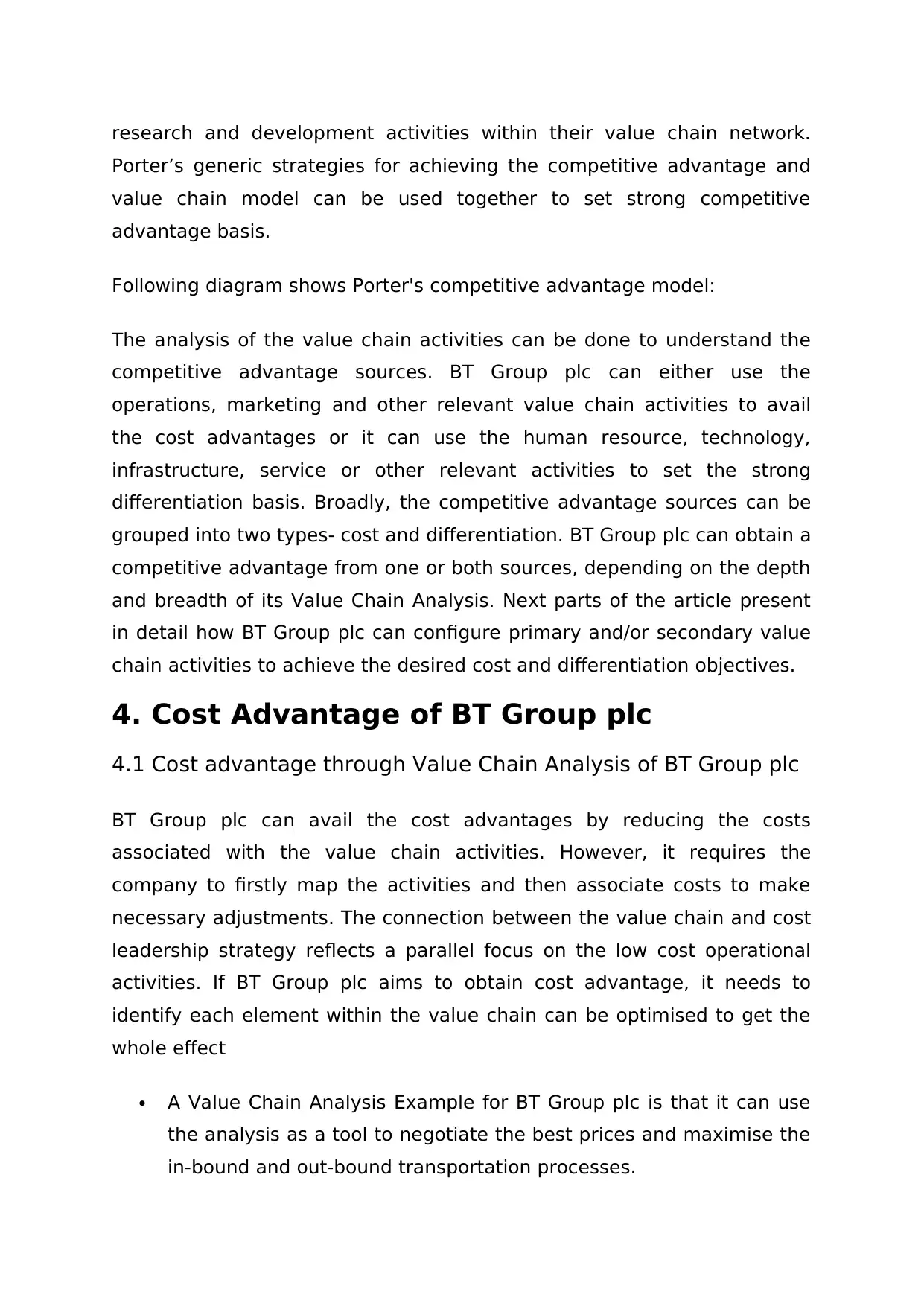
research and development activities within their value chain network.
Porter’s generic strategies for achieving the competitive advantage and
value chain model can be used together to set strong competitive
advantage basis.
Following diagram shows Porter's competitive advantage model:
The analysis of the value chain activities can be done to understand the
competitive advantage sources. BT Group plc can either use the
operations, marketing and other relevant value chain activities to avail
the cost advantages or it can use the human resource, technology,
infrastructure, service or other relevant activities to set the strong
differentiation basis. Broadly, the competitive advantage sources can be
grouped into two types- cost and differentiation. BT Group plc can obtain a
competitive advantage from one or both sources, depending on the depth
and breadth of its Value Chain Analysis. Next parts of the article present
in detail how BT Group plc can configure primary and/or secondary value
chain activities to achieve the desired cost and differentiation objectives.
4. Cost Advantage of BT Group plc
4.1 Cost advantage through Value Chain Analysis of BT Group plc
BT Group plc can avail the cost advantages by reducing the costs
associated with the value chain activities. However, it requires the
company to firstly map the activities and then associate costs to make
necessary adjustments. The connection between the value chain and cost
leadership strategy reflects a parallel focus on the low cost operational
activities. If BT Group plc aims to obtain cost advantage, it needs to
identify each element within the value chain can be optimised to get the
whole effect
A Value Chain Analysis Example for BT Group plc is that it can use
the analysis as a tool to negotiate the best prices and maximise the
in-bound and out-bound transportation processes.
Porter’s generic strategies for achieving the competitive advantage and
value chain model can be used together to set strong competitive
advantage basis.
Following diagram shows Porter's competitive advantage model:
The analysis of the value chain activities can be done to understand the
competitive advantage sources. BT Group plc can either use the
operations, marketing and other relevant value chain activities to avail
the cost advantages or it can use the human resource, technology,
infrastructure, service or other relevant activities to set the strong
differentiation basis. Broadly, the competitive advantage sources can be
grouped into two types- cost and differentiation. BT Group plc can obtain a
competitive advantage from one or both sources, depending on the depth
and breadth of its Value Chain Analysis. Next parts of the article present
in detail how BT Group plc can configure primary and/or secondary value
chain activities to achieve the desired cost and differentiation objectives.
4. Cost Advantage of BT Group plc
4.1 Cost advantage through Value Chain Analysis of BT Group plc
BT Group plc can avail the cost advantages by reducing the costs
associated with the value chain activities. However, it requires the
company to firstly map the activities and then associate costs to make
necessary adjustments. The connection between the value chain and cost
leadership strategy reflects a parallel focus on the low cost operational
activities. If BT Group plc aims to obtain cost advantage, it needs to
identify each element within the value chain can be optimised to get the
whole effect
A Value Chain Analysis Example for BT Group plc is that it can use
the analysis as a tool to negotiate the best prices and maximise the
in-bound and out-bound transportation processes.
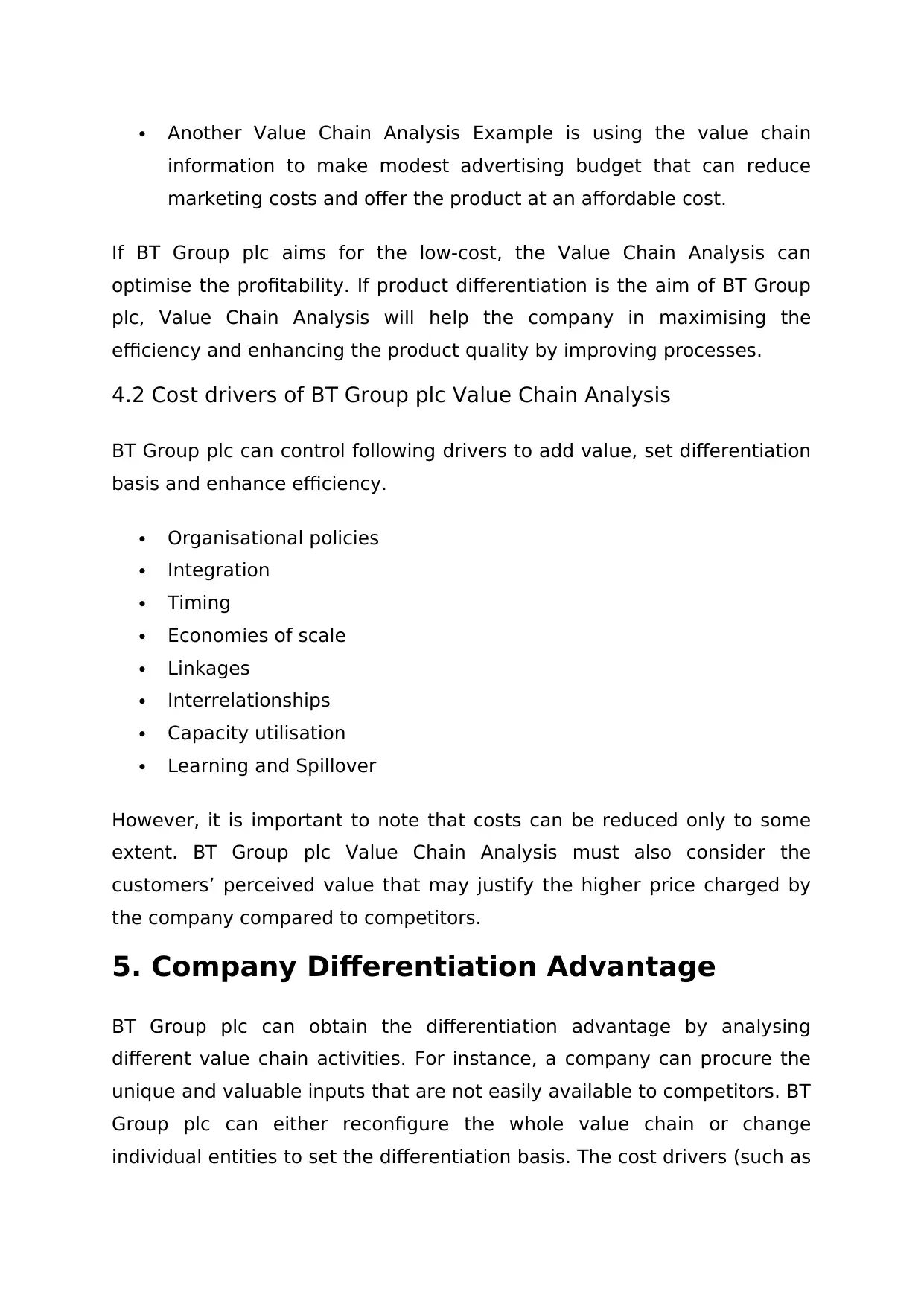
Another Value Chain Analysis Example is using the value chain
information to make modest advertising budget that can reduce
marketing costs and offer the product at an affordable cost.
If BT Group plc aims for the low-cost, the Value Chain Analysis can
optimise the profitability. If product differentiation is the aim of BT Group
plc, Value Chain Analysis will help the company in maximising the
efficiency and enhancing the product quality by improving processes.
4.2 Cost drivers of BT Group plc Value Chain Analysis
BT Group plc can control following drivers to add value, set differentiation
basis and enhance efficiency.
Organisational policies
Integration
Timing
Economies of scale
Linkages
Interrelationships
Capacity utilisation
Learning and Spillover
However, it is important to note that costs can be reduced only to some
extent. BT Group plc Value Chain Analysis must also consider the
customers’ perceived value that may justify the higher price charged by
the company compared to competitors.
5. Company Differentiation Advantage
BT Group plc can obtain the differentiation advantage by analysing
different value chain activities. For instance, a company can procure the
unique and valuable inputs that are not easily available to competitors. BT
Group plc can either reconfigure the whole value chain or change
individual entities to set the differentiation basis. The cost drivers (such as
information to make modest advertising budget that can reduce
marketing costs and offer the product at an affordable cost.
If BT Group plc aims for the low-cost, the Value Chain Analysis can
optimise the profitability. If product differentiation is the aim of BT Group
plc, Value Chain Analysis will help the company in maximising the
efficiency and enhancing the product quality by improving processes.
4.2 Cost drivers of BT Group plc Value Chain Analysis
BT Group plc can control following drivers to add value, set differentiation
basis and enhance efficiency.
Organisational policies
Integration
Timing
Economies of scale
Linkages
Interrelationships
Capacity utilisation
Learning and Spillover
However, it is important to note that costs can be reduced only to some
extent. BT Group plc Value Chain Analysis must also consider the
customers’ perceived value that may justify the higher price charged by
the company compared to competitors.
5. Company Differentiation Advantage
BT Group plc can obtain the differentiation advantage by analysing
different value chain activities. For instance, a company can procure the
unique and valuable inputs that are not easily available to competitors. BT
Group plc can either reconfigure the whole value chain or change
individual entities to set the differentiation basis. The cost drivers (such as
Secure Best Marks with AI Grader
Need help grading? Try our AI Grader for instant feedback on your assignments.
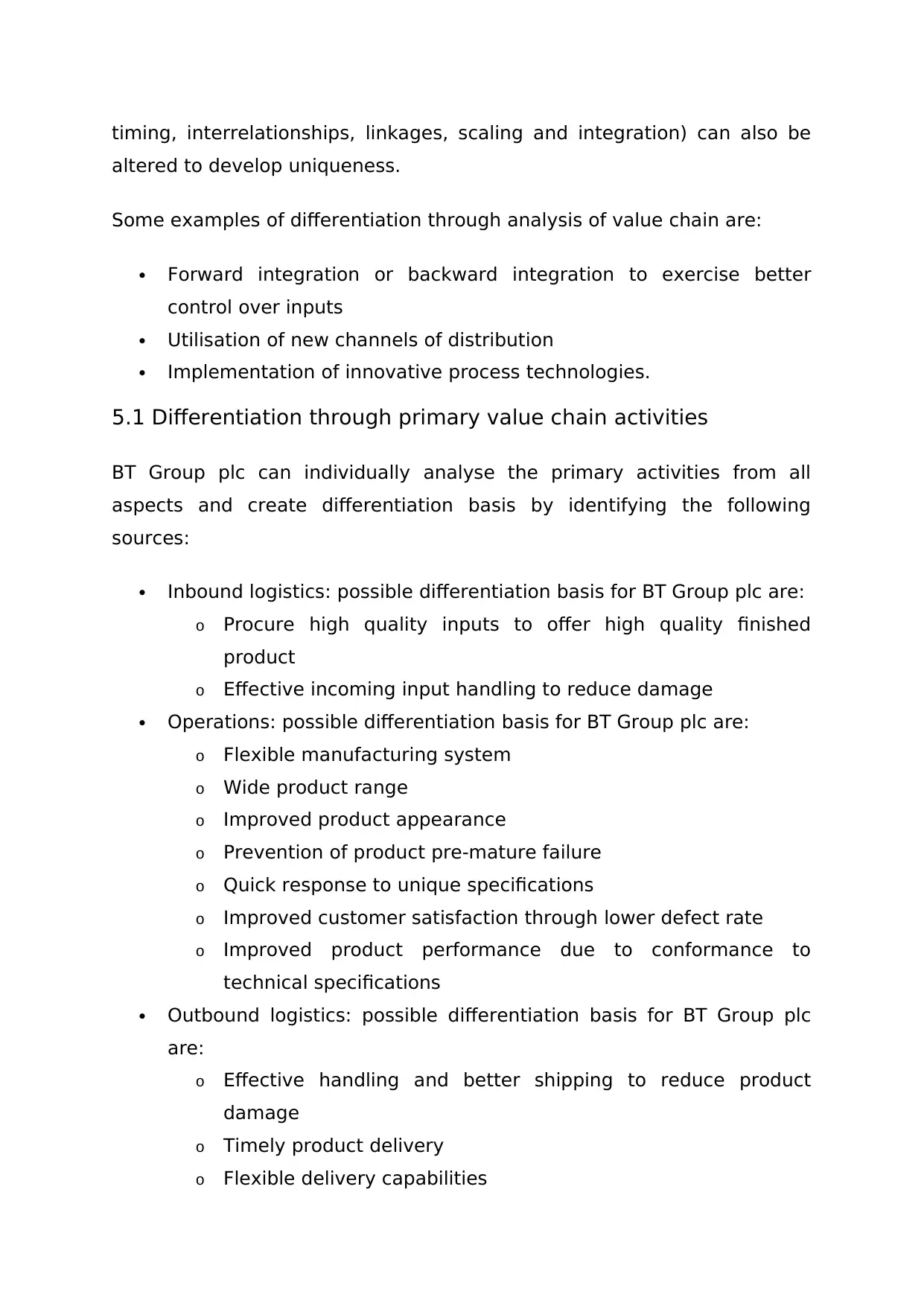
timing, interrelationships, linkages, scaling and integration) can also be
altered to develop uniqueness.
Some examples of differentiation through analysis of value chain are:
Forward integration or backward integration to exercise better
control over inputs
Utilisation of new channels of distribution
Implementation of innovative process technologies.
5.1 Differentiation through primary value chain activities
BT Group plc can individually analyse the primary activities from all
aspects and create differentiation basis by identifying the following
sources:
Inbound logistics: possible differentiation basis for BT Group plc are:
o Procure high quality inputs to offer high quality finished
product
o Effective incoming input handling to reduce damage
Operations: possible differentiation basis for BT Group plc are:
o Flexible manufacturing system
o Wide product range
o Improved product appearance
o Prevention of product pre-mature failure
o Quick response to unique specifications
o Improved customer satisfaction through lower defect rate
o Improved product performance due to conformance to
technical specifications
Outbound logistics: possible differentiation basis for BT Group plc
are:
o Effective handling and better shipping to reduce product
damage
o Timely product delivery
o Flexible delivery capabilities
altered to develop uniqueness.
Some examples of differentiation through analysis of value chain are:
Forward integration or backward integration to exercise better
control over inputs
Utilisation of new channels of distribution
Implementation of innovative process technologies.
5.1 Differentiation through primary value chain activities
BT Group plc can individually analyse the primary activities from all
aspects and create differentiation basis by identifying the following
sources:
Inbound logistics: possible differentiation basis for BT Group plc are:
o Procure high quality inputs to offer high quality finished
product
o Effective incoming input handling to reduce damage
Operations: possible differentiation basis for BT Group plc are:
o Flexible manufacturing system
o Wide product range
o Improved product appearance
o Prevention of product pre-mature failure
o Quick response to unique specifications
o Improved customer satisfaction through lower defect rate
o Improved product performance due to conformance to
technical specifications
Outbound logistics: possible differentiation basis for BT Group plc
are:
o Effective handling and better shipping to reduce product
damage
o Timely product delivery
o Flexible delivery capabilities
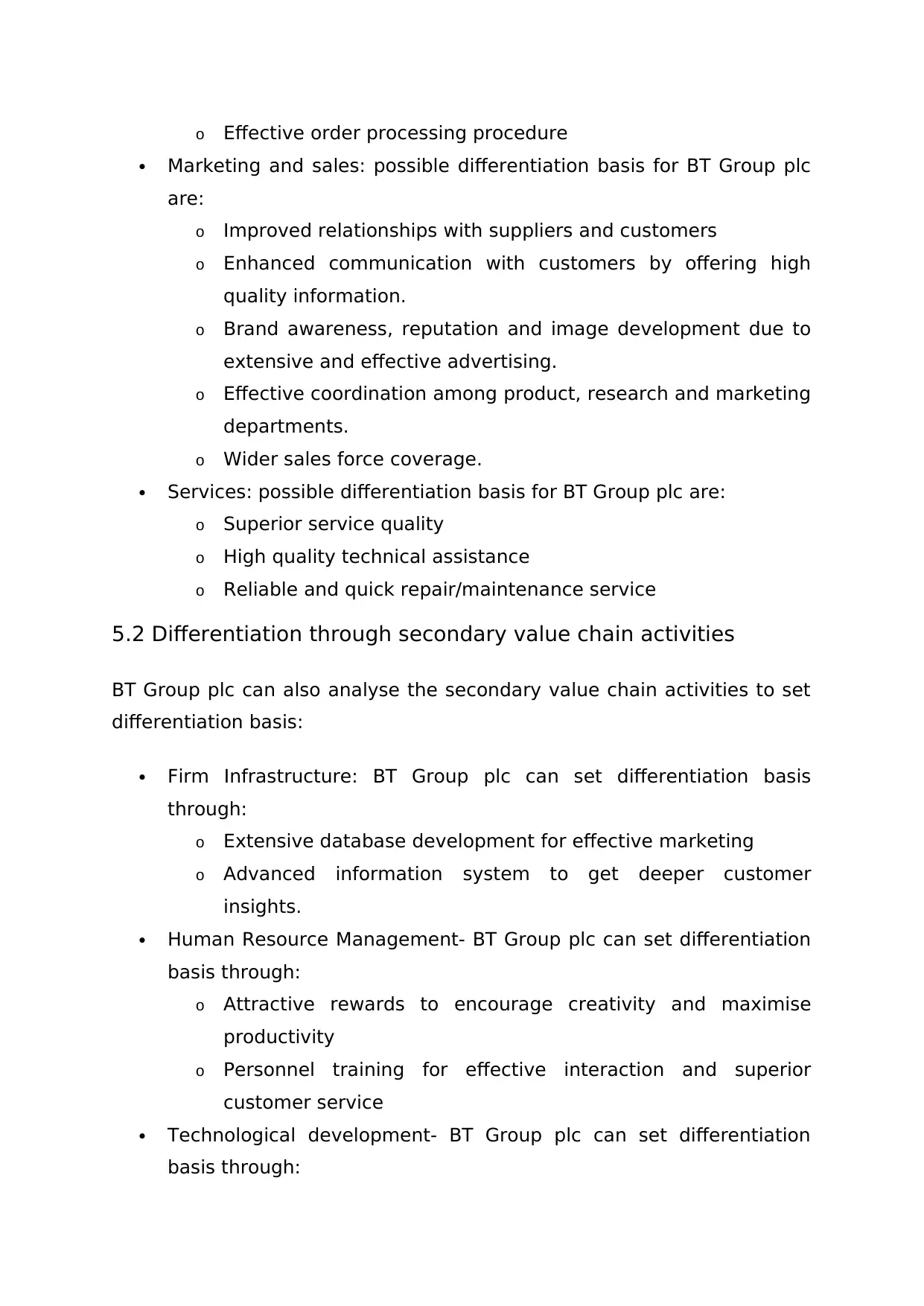
o Effective order processing procedure
Marketing and sales: possible differentiation basis for BT Group plc
are:
o Improved relationships with suppliers and customers
o Enhanced communication with customers by offering high
quality information.
o Brand awareness, reputation and image development due to
extensive and effective advertising.
o Effective coordination among product, research and marketing
departments.
o Wider sales force coverage.
Services: possible differentiation basis for BT Group plc are:
o Superior service quality
o High quality technical assistance
o Reliable and quick repair/maintenance service
5.2 Differentiation through secondary value chain activities
BT Group plc can also analyse the secondary value chain activities to set
differentiation basis:
Firm Infrastructure: BT Group plc can set differentiation basis
through:
o Extensive database development for effective marketing
o Advanced information system to get deeper customer
insights.
Human Resource Management- BT Group plc can set differentiation
basis through:
o Attractive rewards to encourage creativity and maximise
productivity
o Personnel training for effective interaction and superior
customer service
Technological development- BT Group plc can set differentiation
basis through:
Marketing and sales: possible differentiation basis for BT Group plc
are:
o Improved relationships with suppliers and customers
o Enhanced communication with customers by offering high
quality information.
o Brand awareness, reputation and image development due to
extensive and effective advertising.
o Effective coordination among product, research and marketing
departments.
o Wider sales force coverage.
Services: possible differentiation basis for BT Group plc are:
o Superior service quality
o High quality technical assistance
o Reliable and quick repair/maintenance service
5.2 Differentiation through secondary value chain activities
BT Group plc can also analyse the secondary value chain activities to set
differentiation basis:
Firm Infrastructure: BT Group plc can set differentiation basis
through:
o Extensive database development for effective marketing
o Advanced information system to get deeper customer
insights.
Human Resource Management- BT Group plc can set differentiation
basis through:
o Attractive rewards to encourage creativity and maximise
productivity
o Personnel training for effective interaction and superior
customer service
Technological development- BT Group plc can set differentiation
basis through:
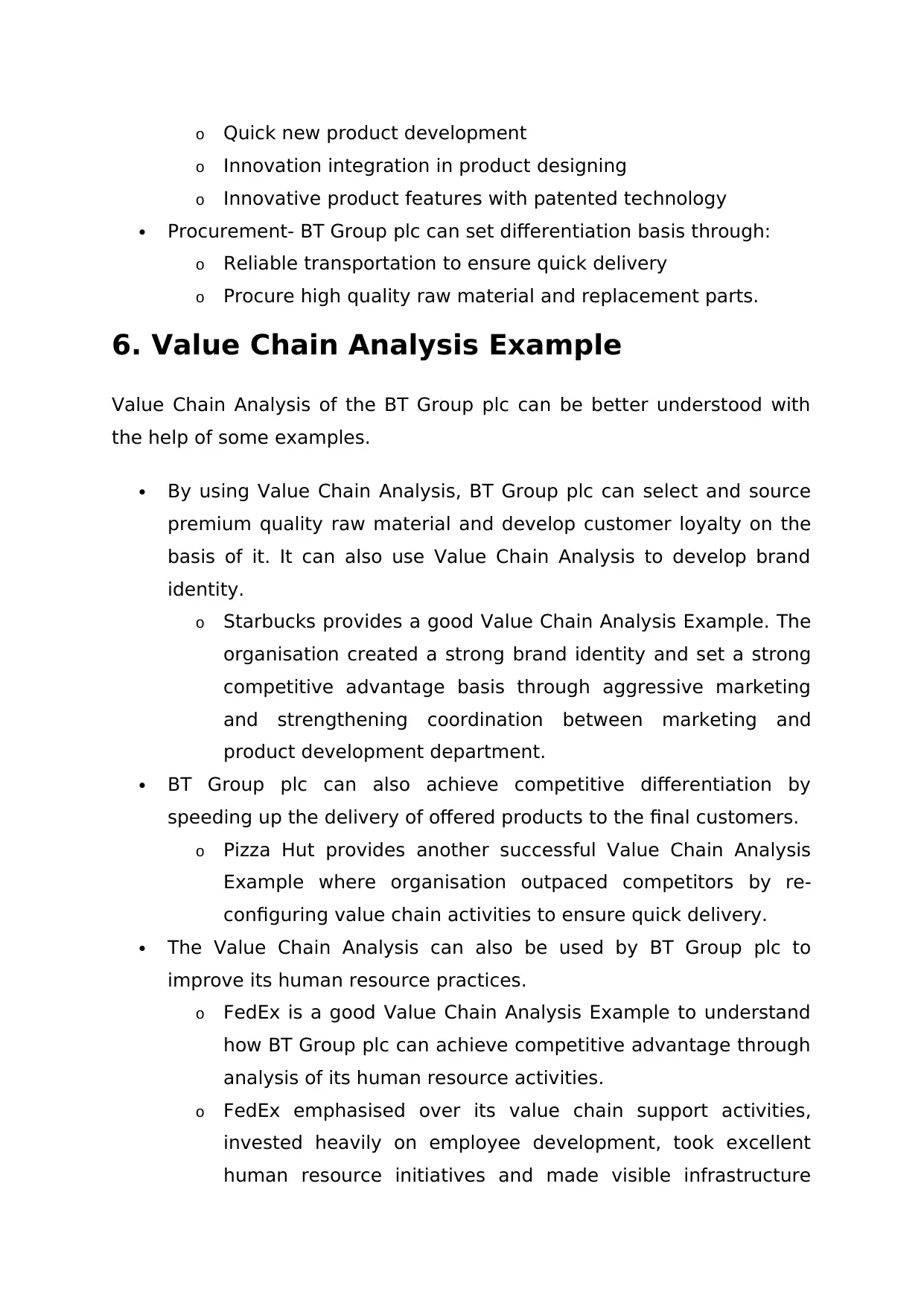
o Quick new product development
o Innovation integration in product designing
o Innovative product features with patented technology
Procurement- BT Group plc can set differentiation basis through:
o Reliable transportation to ensure quick delivery
o Procure high quality raw material and replacement parts.
6. Value Chain Analysis Example
Value Chain Analysis of the BT Group plc can be better understood with
the help of some examples.
By using Value Chain Analysis, BT Group plc can select and source
premium quality raw material and develop customer loyalty on the
basis of it. It can also use Value Chain Analysis to develop brand
identity.
o Starbucks provides a good Value Chain Analysis Example. The
organisation created a strong brand identity and set a strong
competitive advantage basis through aggressive marketing
and strengthening coordination between marketing and
product development department.
BT Group plc can also achieve competitive differentiation by
speeding up the delivery of offered products to the final customers.
o Pizza Hut provides another successful Value Chain Analysis
Example where organisation outpaced competitors by re-
configuring value chain activities to ensure quick delivery.
The Value Chain Analysis can also be used by BT Group plc to
improve its human resource practices.
o FedEx is a good Value Chain Analysis Example to understand
how BT Group plc can achieve competitive advantage through
analysis of its human resource activities.
o FedEx emphasised over its value chain support activities,
invested heavily on employee development, took excellent
human resource initiatives and made visible infrastructure
o Innovation integration in product designing
o Innovative product features with patented technology
Procurement- BT Group plc can set differentiation basis through:
o Reliable transportation to ensure quick delivery
o Procure high quality raw material and replacement parts.
6. Value Chain Analysis Example
Value Chain Analysis of the BT Group plc can be better understood with
the help of some examples.
By using Value Chain Analysis, BT Group plc can select and source
premium quality raw material and develop customer loyalty on the
basis of it. It can also use Value Chain Analysis to develop brand
identity.
o Starbucks provides a good Value Chain Analysis Example. The
organisation created a strong brand identity and set a strong
competitive advantage basis through aggressive marketing
and strengthening coordination between marketing and
product development department.
BT Group plc can also achieve competitive differentiation by
speeding up the delivery of offered products to the final customers.
o Pizza Hut provides another successful Value Chain Analysis
Example where organisation outpaced competitors by re-
configuring value chain activities to ensure quick delivery.
The Value Chain Analysis can also be used by BT Group plc to
improve its human resource practices.
o FedEx is a good Value Chain Analysis Example to understand
how BT Group plc can achieve competitive advantage through
analysis of its human resource activities.
o FedEx emphasised over its value chain support activities,
invested heavily on employee development, took excellent
human resource initiatives and made visible infrastructure
Paraphrase This Document
Need a fresh take? Get an instant paraphrase of this document with our AI Paraphraser
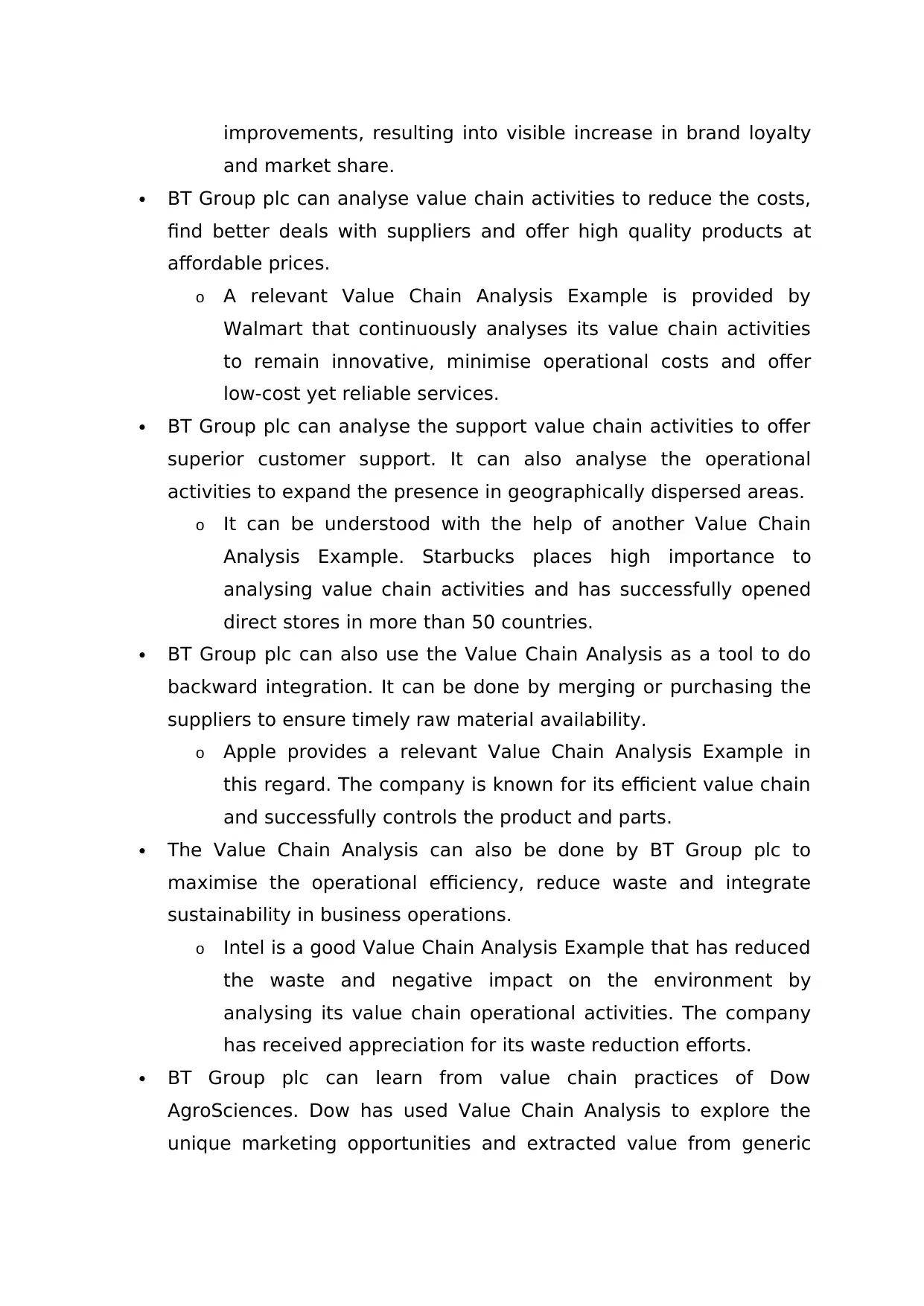
improvements, resulting into visible increase in brand loyalty
and market share.
BT Group plc can analyse value chain activities to reduce the costs,
find better deals with suppliers and offer high quality products at
affordable prices.
o A relevant Value Chain Analysis Example is provided by
Walmart that continuously analyses its value chain activities
to remain innovative, minimise operational costs and offer
low-cost yet reliable services.
BT Group plc can analyse the support value chain activities to offer
superior customer support. It can also analyse the operational
activities to expand the presence in geographically dispersed areas.
o It can be understood with the help of another Value Chain
Analysis Example. Starbucks places high importance to
analysing value chain activities and has successfully opened
direct stores in more than 50 countries.
BT Group plc can also use the Value Chain Analysis as a tool to do
backward integration. It can be done by merging or purchasing the
suppliers to ensure timely raw material availability.
o Apple provides a relevant Value Chain Analysis Example in
this regard. The company is known for its efficient value chain
and successfully controls the product and parts.
The Value Chain Analysis can also be done by BT Group plc to
maximise the operational efficiency, reduce waste and integrate
sustainability in business operations.
o Intel is a good Value Chain Analysis Example that has reduced
the waste and negative impact on the environment by
analysing its value chain operational activities. The company
has received appreciation for its waste reduction efforts.
BT Group plc can learn from value chain practices of Dow
AgroSciences. Dow has used Value Chain Analysis to explore the
unique marketing opportunities and extracted value from generic
and market share.
BT Group plc can analyse value chain activities to reduce the costs,
find better deals with suppliers and offer high quality products at
affordable prices.
o A relevant Value Chain Analysis Example is provided by
Walmart that continuously analyses its value chain activities
to remain innovative, minimise operational costs and offer
low-cost yet reliable services.
BT Group plc can analyse the support value chain activities to offer
superior customer support. It can also analyse the operational
activities to expand the presence in geographically dispersed areas.
o It can be understood with the help of another Value Chain
Analysis Example. Starbucks places high importance to
analysing value chain activities and has successfully opened
direct stores in more than 50 countries.
BT Group plc can also use the Value Chain Analysis as a tool to do
backward integration. It can be done by merging or purchasing the
suppliers to ensure timely raw material availability.
o Apple provides a relevant Value Chain Analysis Example in
this regard. The company is known for its efficient value chain
and successfully controls the product and parts.
The Value Chain Analysis can also be done by BT Group plc to
maximise the operational efficiency, reduce waste and integrate
sustainability in business operations.
o Intel is a good Value Chain Analysis Example that has reduced
the waste and negative impact on the environment by
analysing its value chain operational activities. The company
has received appreciation for its waste reduction efforts.
BT Group plc can learn from value chain practices of Dow
AgroSciences. Dow has used Value Chain Analysis to explore the
unique marketing opportunities and extracted value from generic
1 out of 14
Related Documents
Your All-in-One AI-Powered Toolkit for Academic Success.
+13062052269
info@desklib.com
Available 24*7 on WhatsApp / Email
![[object Object]](/_next/static/media/star-bottom.7253800d.svg)
Unlock your academic potential
© 2024 | Zucol Services PVT LTD | All rights reserved.





